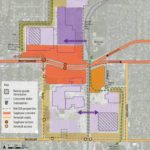Location: Lansing, MI | Client: EPA Region 5 and SRI | Project Date: May 2012 – November 2013
Project Images
Links and Resources
GM Lansing Reuse Framework Report
Project Description
Situation
From 1910-2006, manufacturing operations at three former General Motors properties helped to drive the local economy in Michigan’s capitol. In 2005 and 2006, the former General Motors Corp. ceased operations at Plants 2, 3 and 6; and in 2011, the Revitalizing Auto Communities Environmental Response Trust (the RACER Trust) assumed ownership of the three properties as part of its mission to clean up and re-position inactive former GM properties for redevelopment.
Since the closure of the three plants in 2006, the City of Lansing (Plant 6) and Lansing Township (Plants 2 and 3) have conducted independent planning efforts for the former GM plants that outline goals for green industry and mixed-use development. However, the site and communities face several challenges that have complicated the redevelopment process, including the 240-acre site area which spans two separate jurisdictions and a legacy of contamination.
Solution
With funding from the EPA Region 5, Skeo Solutions led an areawide brownfield redevelopment process that provided an opportunity to integrate planning goals into a unified redevelopment framework. As part of the process, Skeo facilitated a day-long strategic planning workshop that brought together City and Township decision-makers, RACER Trust, local economic development officials and representatives of state regulatory and economic development agencies to refine goals and reuse priorities and identify redevelopment opportunities and incentives. To support discussions, Skeo developed an existing conditions analysis highlighting ownership, surrounding land use and cleanup considerations.
Outcome
Based on the outcomes of the working session, Skeo developed a reuse framework for the GM Lansing Plants 2, 3 and 6 that integrates reuse goals and principles, remedial considerations, a future land use plan, and a renewable energy screening to help align cleanup and future use planning. The reuse framework provides a shared vision to coordinate redevelopment across multiple entities and concludes with near-term action steps and relevant funding sources. Prioritized strategies include:
- Mixed-Use Development Approach: The site suitability and future land use framework provide a mixed-use redevelopment concept that accommodates multiple stakeholder goals and development types to can help align cleanup and redevelopment efforts.
- Joint Planning District: The process identified an opportunity to create a joint planning and financing district spanning the three properties to help enforce the concept of borderless redevelopment.
- Renewable Energy Opportunities: Part of the reuse framework evaluated renewable energy opportunities at the site and identified site infrastructure and land availability to support a biomass processing and packaging facility as part of a green technology park, and the potential to integrate small-scale solar or wind facilities for on-site use.



